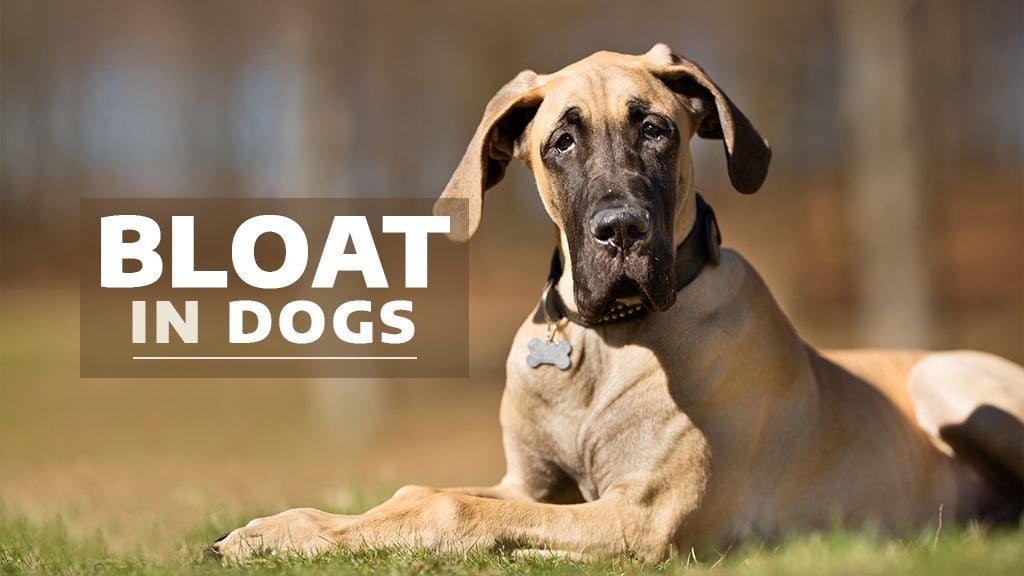Bloat in Dogs
)
What is bloat in dogs?
Gastric dilation-volvulus (GDV or bloat), is a serious condition that can be quickly fatal and is considered as a veterinary emergency.
It’s a condition in which food, gas, or fluids stretch a dog’s stomach, causing abdominal pain and a sudden increase in the dog's abdomen.
In severe cases, stomach distension can be accompanied by twisting, which can cut off blood flow to the abdomen and stomach. This can cause injury to the stomach wall, put pressure on the diaphragm (causing difficulties breathing), and damage other internal organs.
Symptoms of bloat for dogs
A dog affected by bloat will seem visibly uncomfortable or distressed.
Physical signs of bloat in dogs:
A swollen, often firm belly
Accelerated heart rate (tachycardia)
Pale gums
Behavioural signs of bloat in dogs:
Dry heaving and retching (often spitting out white foam or clear mucous)
Anxious behaviours such as pacing back and forth, or changing resting positions often
Unusual or excessive panting and drooling
In severe cases, a pet affected by bloat may even collapse and be unwilling to move.
Causes of bloat in dogs
There are many suspected risk factors of bloat in dogs, and like many conditions, a dog’s age, breed, and health status can be factors.
Larger breed dogs are at a higher risk of GDV than smaller ones, with deep-chested breeds also at risk.
Great Dane
Weimaraner
Mastiff
St Bernard
Irish Setter
Shar Pei
Basset Hound
German Shepherd
Standard Poodle
Dachshund
Age also seems to play a role in the risk, increasing with dogs over 4.5 years of age.
Feeding behaviours have also been linked to an increase in the risk of GDV.
Factors that may increase the risk of bloat:
Deep chested dogs
Older dogs
Leaner dogs
Once-daily feeding
Small food particles
Presence of oil or fat amongst the first four ingredients in dry food
A large amount of food fed at one sitting
Feeding on an elevated bowl
Eating quickly or gulping air
Exercise following a meal
Underlying stomach motility problem
Tips to reduce the chances of bloat in your dog
Many tips to reduce the risks of bloat in your pets are related to your pet’s diet and eating routines. Some ways you could reduce the chances of bloat in your pet include:
Avoid raised food bowls
Wait to feed pets at least 30 minutes to an hour before or after exercise
Encourage smaller, more frequent trips to the water bowl by inviting pets to get up more often and guiding them toward it
Using slow feeders to prevent gorging, or spreading meals out into smaller portions over intervals- small meals 2-3 times daily
Avoid sudden diet changes
Avoiding sharing food scraps and keeping bins out of access
What to do if you suspect your pet has GDV or is affected by bloat
A pet that is suspected of bloat should seek veterinary attention immediately, GDV is a serious emergency that can be quickly fatal.
Veterinary treatment may include:
- Fluid and oxygen therapy
- Stomach decompression to release the air and fluid
- General anesthesia and surgery to re-position the stomach
- Hospitalisation
The prognosis for GDV is fair to good with early detection, prompt gastric decompression, and surgery. However, unfortunately, it is estimated that 10-15% of dogs that experience a GDV die due to complications. This is more likely to happen in pets that are not treated within 6 hours of clinical signs, experience heart difficulties prior to surgery, or require surgical removal of some of the stomach or spleen.
Prophylactic Gastropexy
This is a surgical procedure performed to decrease the risk of GDV, and is often performed in high-risk young dogs, frequently at the time of desexing. The stomach is surgically 'tacked' to the body wall to hold it in place decreasing the risk of it twisting later in life. Do not hesitate to make an appointment with one of our vets for more information and advice regarding this procedure.
| Tags:DogClient InformationHealth AdviceProactive Pet Care |
&geometry(126x115))